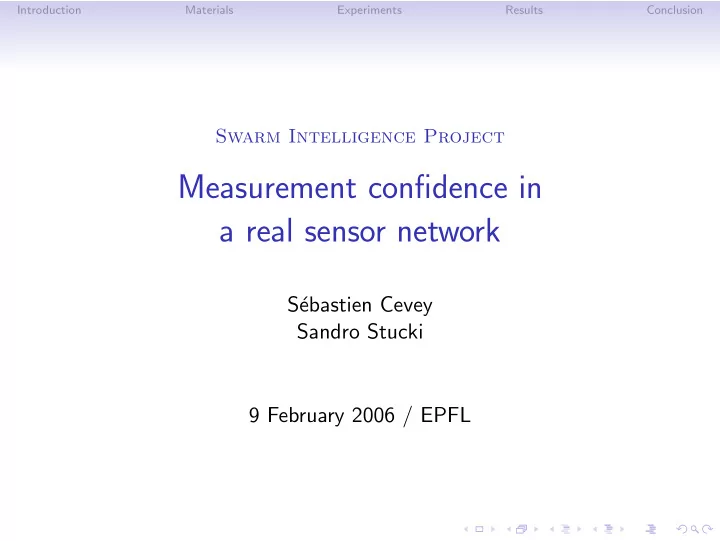

Introduction Materials Experiments Results Conclusion Swarm Intelligence Project Measurement confidence in a real sensor network S´ ebastien Cevey Sandro Stucki 9 February 2006 / EPFL
Introduction Materials Experiments Results Conclusion Overview Introduction Materials Experiments Results Conclusion
Introduction Materials Experiments Results Conclusion Problem • Sensor networks efficient at gathering data over a wide area • Nodes (AKA motes) may encounter failures : • Erroneous sensing • Transmission packet loss • System crash • Need a way to assess the quality of acquired data
Introduction Materials Experiments Results Conclusion Goal Exploit the distributed nature of sensor networks : • Use neighbors’ measurements to reinforce confidence • Distribute computation of result value = ⇒ Improve quality of measurements for various network layouts
Introduction Materials Experiments Results Conclusion Materials Hardware MICAz motes : light sensor, radio System TinyOS : component-based Language NesC : asynchroneous, C-like Base station Megabase client in Java
Introduction Materials Experiments Results Conclusion Method : state-based controller immediately INIT SYNC after after sync msg last send received + sleep delay ADC SLEEP WARMUP after after warmup 2nd send delay delay BCST BCST LISTEN RESULT after 1st send delay • Initial synchronization (sync message from Megabase) • Two broadcasts (timer triggered) : measurement, evaluation • Inactive period (sleep)
Introduction Materials Experiments Results Conclusion Method : linear result computation Measurement vector : − → d Evaluation matrix : M Result vector : r = M · − → − → d Example evaluation matrix (Gaussian filter) : 6 1 0 0 1 · · · 1 6 1 0 0 1 6 M = . . ... . . . . 0 6 1 1 0 1 6 · · ·
Introduction Materials Experiments Results Conclusion Experiment 1 : Distributed Filtering • Rotating lamp on circle of motes • Measurements every two cycles (4 seconds) 9 10 8 1 7 2 6 after 2 cycles 3 5 4 Experiment 1A Identity matrix as evaluation matrix Experiment 1B Gaussian filter of size 3
Introduction Materials Experiments Results Conclusion Experiment 2 : Sensing under Real Conditions 1/2 3/4 5/6 9/10 7/8 Base Station BC217 BC221 BC225 BC294.6 (Corridor) • Real environment (rooms in BC) • Measurements every minute during 24 hours • Considering both pair motes (weight 2) and two neighboring pairs (weight 1)
Introduction Materials Experiments Results Conclusion Results for Experiment 1 • Light travelling wave visible in both experiments • Mote 3 not working in Experiment 1A • Results smoother in Experiment 1B (Gaussian filter)
Introduction Materials Experiments Results Conclusion Results for Experiment 2 : Measurements of all motes Experiment 2 (altered) 1000 Mote 1 Mote 2 Mote 3 Mote 4 900 Mote 5 Mote 6 Mote 7 Mote 8 800 Mote 9 Mote 10 Result 700 600 500 400 0 200 400 600 800 1000 1200 Time (min) Light evolution matches closely with environment (daylight, lamps), expected results.
Introduction Materials Experiments Results Conclusion Results for Experiment 2 : Measurements vs. Results comparison for a pair of motes Experiment 2 (results vs measurements) 8000 Mote 7 results Mote 8 results 7000 Mote 7 measurements Mote 8 measurements 6000 5000 Measurement Result 4000 3000 2000 1000 0 0 200 400 600 800 1000 1200 1400 Time (min) Clean measurements, noisy computed results (due to packet loss).
Introduction Materials Experiments Results Conclusion Conclusion • Flexible system adaptable to varied network layouts using the evaluation matrix. • Disappointing results due to bad handling of packet loss (easy to improve). • Interesting insight in distributed computations , as needed in large-scale sensor networks.
Recommend
More recommend